|
|
Sonatas for Viola da Gamba & Harpsichord BWV 1027-1029
Bach’s Sonatas for Viola da gamba and Harpsichord |
|
1 |
Bach: Die Sonaten für Viola da Gamba und Cembalo -
Les sonates pour viole de gambe et clavecin [H-3]
[H-4] |


|
|
Trio Sonata No. 5 iC major, BWV
529, arranged by Jordi Savall
[14:01]
Sonatas for viola da gamba & keyboard, BWV
1027-1029 [13:50, 15:18, 15:21] |
|
Jordi Savall (Viola
da gamba); Ton Koopman (Harpsichord) |
|
Alia Vox AV-9812. |
Jan 3-5, 2000 |
CD / TT: 58:40
MP3 / TT: 58:32 |
|
Recorded at la Collégiale du Château de
Gardona, Catalogne, Spain.
2nd recording of sonatas for viola da gamba & keyboard BWV
1027-1029 by J. Savall & T. Koopman.
Buy this album at:
CD (2000): Amazon.com
| Amazon.co.uk
| Amazon.de
Music Download: Amazon.com
| Amazon.co.uk
| Amazon.de |
|
2 |
J.S. Bach: Sonatas for Viola da gamba & Harpsichord [H-1] |
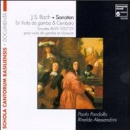 |
|
1-3. Sonatas for Viola da gamba & Harpsichord BWV 1027-1029 [13:50, 13:59, 15:20]
4. Suite for viola da gamba in D minor, constructed by Paolo Pandolfo from BWV 1011 and 995 [24:55] |
|
Paolo Pandolfo (viola da gamba); Rinaldo Alessandrini (harpsichord) |
|
Harmonia Mundi |
1993 [3]; 1994 [1-3] |
CD / TT: 68:04 |
|
Buy this album at: Amazon.com | Amazon.com |
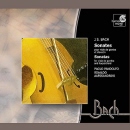
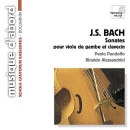 |
|
3 |
Edition Bachakademie Vol. 124 - Sonatas for Viola da gamba & Harpsichord [H-1] |
 |
|
Sonatas for viola da gamba & harpsichord BWV 1027-1029 [11:54, 12:48, 13:05 |
|
Hille Perl (Viola da gamba); Michael Behringer (Harpsichord) |
|
Hänssler |
Dec 1998 |
CD / TT: 37:44 |
|
Recorded at Kath. Pfrarrkirche Oberried, Germany.
Buy this album at: Amazon.com | Amazon.de |
|
4 |
J.S. Bach: Gamba Sonatas [H-4]
[H-7] |

|
|
Sonata for viola da gamba & harpsichord No. 1 in G
major, BWV 1027 [13:24]
Capriccio on the Departure of a Beloved Brother in B flat major, BWV
992 [11:24]
Sonata for viola da gamba & harpsichord No. 2 in D major, BWV
1028 [14:46]
Capriccio in honour of J.C. Bach in E major, BWV
993 [6:35]
Sonata for viola da gamba & harpsichord No. 3 in G minor, BWV
1029 [14:47] |
|
Jaap ter Linden
(Viola da gamba); Richard Egarr
(Harpsichord) |
|
Harmonia Mundi HMU-907268 |
Jul 10-19, 1999
Oct 17-19, 1999 |
CD / TT: 61:06
MP3 / TT: 61:07 |
|
Recorded at St. George's Brandon Hill, Bristol, Angleterre,
England.
2nd recording of Sonatas for viola da gambe & harpsichord
BWV 1027-1029 by R. Egarr.
2nd recording of Sonatas for viola da gamba & harpsichord
BWV 1027-1029 by J.t. Linden.
Buy this album at:
CD (2000): Amazon.com
| Amazon.co.uk
| Amazon.de
Music Download: Amazon.com
| Amazon.co.uk
| Amazon.de |
|
6 |
J.S. Bach: Sonatas for viola da gamba & harpsichord [H-1] |
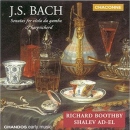 |
|
Toccatas No. 4 BWV 913 [11:27], No. 5 BWV 914 [7:31]
Sonatas for viola da gamba & keyboard BWV 1027-1029 [12:12, 13:12, 13:20] |
|
Richard Boothby (Viola da gamba); Shalev Ad-El (Harpsichord) |
|
Chandos |
Jan 1996 |
CD / TT: 58:08 |
|
Recorded at Orford Church.
Buy this album at: Amazon.com | Amazon.de |
|
7 |
J.S. Bach: Sonates pour viola de gambe et clavecin [H-1] |
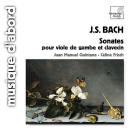 |
|
Sonata for violin & keyboard No. 6 in G major, BWV 1019, transcribed for viola da gamba & harpsichord [16:39]
Sonatas for viola da gamba & keyboard BWV 1027-1029 [12:43, 13:45, 14:11] |
|
Juan Manuel Quintana (Viola da gamba); Céline Frisch (Harpsichord) |
|
Harmonia Mundi France |
Feb 2000 |
CD / TT: 57:18 |
|
Recorded at Salle du Reitstadel, Neumarkt.
Buy this album at: Amazon.com |
 |
|
8 |
Bach: Gamba Sonatas [H-1] |
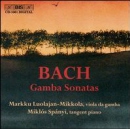 |
|
Sonatas for viola da gamba & keyboard BWV 1027-1029 [13:26, 14:59, 15:46]
Sonata for flute & keyboard in B minor, BWV 1030 [19:20] |
|
Markku Luolajan-Mikkola (Viola da gamba); Miklós Spányi (Tangent Piano) |
|
BIS |
May 1999 |
CD / TT: 63:31 |
|
Recorded at Phoenix Studio, Bedapest, Hungary.
Buy this album at: Amazon.com |
|
10 |
J.S. Bach: Gamba Sonatas · Riddle Preludes · Baroque
Perpetua [H-2] [H-1] |

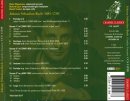
|
|
1. WTC 1: Prelude and Fugue, for keyboard No. 1 in C
major, BWV 846 [1:57]
2. Sonata for viola da gamba & harpsichord No. 1 in G major, BWV
1027 [12:40]
2. Concerto for harpsichord, strings & continuo No. 2 in E major, BWV
1053: Siciliano [4:41]
4. Suite for solo cello No. 1 in G major, BWV 1007: Prelude [2:12]
5. Sonata for viola da gamba & harpsichord No. 2 in D major, BWV
1028 [14:14]
6. Italian Concerto in F major, BWV 971:
Andante [4:34]
7. Prelude for lute in C minor, BWV 999
[1:47]
8. Sonata for viola da gamba & harpsichord No. 3 in G minor, BWV
1029 [14:22]
9. Concerto for harpsichord, strings & continuo No. 5 in F minor, BWV
1056: Largo [ 2:36] |
|
Pieter Wispelwey
(Violoncello Piccolo [2, 5, 8], (Cello) [1, 3, 5-7, 9]; Richard
Egarr (Organ) [2-3, 6], (Fortepiano) [5], Harpsichord) [8-9]; Daniel
Yeadon (BarCello) [2-4, 6, 8, 9] |
|
Channel Classics CCS-14198 |
Jun 1996 |
CD / TT: 59:17 |
|
Recorded in Renswoude, the Netherlands.
1st recording of Sonatas for viola da gambe & harpsichord
BWV 1027-1029 by R. Egarr.
2nd recording of Italian Concerto BWV 971 by R. Egarr.
Buy this album at:
CD:Amazon.com
| Amazon.co.uk
| Amazon.de
| Amazon.de
Music Download: Amazon.com
| Amazon.co.uk
| Amazon.de |
|
Part 1 |
|
Donald Satz wrote (May 14, 2001):
It is commonly thought that the viola da gamba was an outdated instrument as the 1700's progressed; therefore, Bach's use of this instrument for his three Sonatas BWV 1027-29 is seen as another indication of how he often looked to the past for his musical inspira. A different and more recent point of view is that the viola da gamba retained a healthy degree of popularity in France and Germany until the last decades of the 18th century. Also, the more recent consensus is that Bach composed these three works in the 1740's, not in the 1720's as was the routine thinking.
The cello, which comes from the violin family, would ultimately supplant the viola da gamba. In recordings of BWV 1027-29, it isn't rare for the cello to take the place of the viola da gamba; two of the recordings I am reviewing take this route. Also, there is no law mandating the use of the harpsichord, and other instruments used in the recordings reviewed include tangent piano, organ, and fortepiano.
For the review, I offer the following period instrument recordings:
Alia Vox 9812 - Jordi Savall on viola da gamba, Ton Koopman on harpsichord.
Harmonia Mundi 2955218 - Paolo Pandolfo on viola da gamba, Rinaldo Alessandrini on harpsichord.
Hänssler 92124 - Hille Perl on viola da gambaMichael Behringer on harpsichord.
Harmonia Mundi 907268 - Jaap ter Linden on viola da gamba, Richard Egarr on harpsichord.
Signum 024 - Alison Crum on viola da gamba, Laurence Cummings on harpsichord.
Chandos 0608 - Richard Boothby on viola da gamba, Shalev Ad-El on harpsichord.
Harmonia Mundi 901712 - Juan Manuel Quintana on viola da gamba, Céline Frisch on harpsichord.
BIS 1061 - Markku Luolajan-Mikkola on viola da gamba, Miklós Spányi on tangent piano.
Sony Vivarte 45945 - Anner Bylsma on violoncello piccolo, Bob van Asperen on organ.
Channel Classics 14198 - Pieter Wispelwey on violoncello piccolo, Richard Egarr on harpsichord/organ/fortepiano, and Daniel Yeadon on baroque cello.
A few comments about these recordings before starting the review:
1. The three Sonatas allow plenty of room on a cd for additional music. Each of the ten recordings provides more music except for the Perl issue on Hänssler which has less than 40 minutes of music. Hänssler cd's do sell for less than premium price, but I think that the performances would have to be quite excellent to justify purchase.
2. Harmonia Mundi must have a strong liking for the Viola da gamba Sonatas with three recordings over the past six years.
3. I'm not going to go into detail concerning other reviews, but the consensus appears to be in favor of the Pandolfo, Savall, and ter Linden issues. I have not read any reviews of the newest among the ten, the Quintana on Harmonia Mundi. The Signum release has taken some negative comments mainly concerning balances between instruments and some lack of lyricism.
4. Comments about the balances between and among instruments will not be uncommon.
Sonata in G major, BWV 1027 - The G major is likely a transcription of the Sonata in G major for two flutes and bass continuo BWV 1039. The work is in the Sonata da chiesa form with the harpsichord taking the role of the 2nd flute in addition to its continuo role.
The first movement Adagio is bitter/sweet music with the potential for a high degree of nobility and conveying of comfort. There is also great tension in the sustaining notes from the viola da gamba while the harpsichord's right hand is more lively as a counterbalance.
Issues of balance become significant right from the start for three of the versions. On Signum, Alison Crum is recessed compared to her partner Laurence Cummings; sustaining notes have little impact. Richard Egarr occupies a position in the soundstage close to Jaap ter Linden which results in the harpsichord being somewhat overwhelmed by ter Linden. Wispelwey's version has the baroque cello as the continuo and the organ playing the 2nd flute's part. With this combination, both cellos tend to drown out the organ's contribution. Balance problems or not, I do very much enjoy the Crum and ter Linden versions; Cummings is a vibrant and optimistic force at center stage, and ter Linden gives a noble and comforting performance. Wipelwey's version is one I find too dark, heavy, and lacking vitality. Quintana's version is also problematic for different reasons; he is rather sedate and Frisch engages in phrasing which I find square at times.
Pandolfo, Perl, and Bylsma provide fine performances. Pandolfo's reading is the slowest of the ten, Perl the fastest, and van Asperen's organ projects very well compared to Egarr's for Wispelwey.
The readings from Boothby, Luolajan-Mikkola, and Savall are exceptional. Both Savall and Boothby are elegant and noble with great support from their keyboard partners. The Luolajan-Mikkola version is quite distinctive. He and Spanyi are strong in presentation with a reading full of life and tension; the viola da gamba's sustaining notes are very effective. As for the tangent piano, it has a delightfully woody sound and does not take a backseat to the viola da gamba.
The second movement is Allegro ma non tanto. If nothing else, the performances need to be exuberantly delivered; Wispelwey and Bylsma lose that exuberance at times and sound relaxed and calm. I suppose their goal is to heighten contrast and building-up of intensity, but I feel they take it too far and direction is somewhat lost.
The following four performances maintain exuberance and also provide much excitement: Boothby, Pandolfo, Perl, and ter Linden. Even better are the Savall, Quintana, Crum, and Luolajan-Mikkola issues. In addition to exuberance and excitement, these versions invest the music with a noble swagger I find irresistable. Because of the balance situation, Crum has only a supporting role; Cummings rises to the occasion with a wonderful performance brimming with nobility and vitality. Some may consider the BIS performances larger than life and/or too busy, but I'm just totally immersed in their strength and constant determination; the duo has taped into all the juices of life. Whatever your preferences, there is a wide conceptual gulf between the BIS and the Bylsma and Wispelwey versions.
I can well imagine ten different listeners wanting ten different conceptions of the third movement Andante. I love the Wispelwey version, and that might sound odd given that I've commented negatively on the balances and Wispelwey's restraint in the 2nd movement. The performance has a determined walking gait with a great feeling of foreboding coming from the baroque cello. Although the organ is still recessed some, it blends beautifully with the bass from the cello. As for Wispelwey, he projects strongly throughout. The result is a reading of stature with danger around the corner. Wispelwey's is the only version which conveys this level of darkness. All the other readings are fine except for the Bylsma which is very slow and sounds even slower. Although Savall is also slow, there's a vibrancy in his performance entirely lacking with Bylsma who seems to plod his way through the Andante.
Last movements of works in the Sonata da chiesa form tend to be the most exuberant and energetic; that certainly applies to the G major's fourth movement. The energy of this vivacious music is strong and constant with delicious interplay between the instruments.
The same qualities of Wispelwey's excellent third movement are detrimental to the fourth. His is a dark performance with two cellos and organ. Listening to any of the other versions after the Wispelwey was like having a weight taken off my shoulders. Wispelwey and company try to be vivacious, but it's an uphill struggle.
Most of the remaining versions are highly enjoyable with fine levels of energy and vivaciousness. Two are exceptional: Quintana/Frisch and Luolajan-Mikkola/Spanyi. When I first heard Frisch's solo opening, I knew I was in for a special experience; her performance has a bounce and sprightly nature which is irre. Quintana partners her perfectly and provides delightful and incisive tension. The BIS duo once again is big-boned and coming at me on all cylinders. There's no way I can resist their playing. Although the slowest reading, it provides along with the Quintana the greatest sense of supreme joy.
Update: As you could easily surmise, Luolajan-Mikkola/Spanyi delivers my favorite performance of the G major Sonata. I've read that their performances are "in your face". I won't even try to dispute that claim; they are in your face and every other part of you also. I've used that face remark in some past reviews, and it was never intended as a compliment. But there is something different about these BIS performances. It's as if they get in your mouth, get swallowed and enter the bloodstream. They totally penetrate my being.
Savall and Koopman are doing great. The balances are on target, and their performances are as stately as possible without ever downplaying energy or joy. Quintana and Frisch would be at Savall's level except for their lack-luster and somewhat square first movement; their fourth movement is a stunner.
The Signum release can objectively be cited for poor balance which often obscures Crum's viola da gamba, but I'm still getting a kick out of the performances. Cummings is giving excellent readings and is the toast of the town. Boothby and Ad-El are also providing me with much pleasure. Boothby's performances have been referred to as lacking in expressiveness; I haven't noticed that at all up to this point.
Ter Linden/Egarr, Pandolfo/Alessandrini, and Perl/Behringer are doing well. I don't have any complaints, but I also haven't heard anything special or particularly enlightening so far.
I find the Wispelwey and Bylsma versions of the G major Sonata the least enjoyable. My basic feeling about Wispelwey's G major is that the combination of instruments he provides probably isn't a good match for the key of G major. Bylsma can't fault van Asperen at all; his organ contribution has been excellent and well projected. Bylsma has been problematic as he tends to become rather sedate and calming even when high energy is called for. He did this to some degree as well in his more recent set of the Solo Cello Suites.
Part 2 will start with the Sonata in D major. For this one, Wispelwey replaces the organ and baroque cello with just a fortepiano. We'll see if the new instrumentation pays any dividends. |
| |
|
Part 2 |
|
Donald Satz wrote (June 4, 2001):
Sonata in D major, BWV 1028 - There's been some speculation concerning whether this Sonata is entirely Bach's creation, and the first movement adagio could make one wonder. Although it has a nice 'walking gait' from the harpsichord's left hand, I find it less inspired than any of the movements in BWV 1027. It's quite short, a little under two minutes. Normally, Bach can easily develop diversity of themes within that time frame, but it doesn't happen in this Adagio. None of the reviewed performances is able to make more of the Adagio than it appears to possess, but each one is fine except for Bylsma/van Asperen. In this instance, van Asperens's organ is problematic for me. It's very far foward and bright; I find the sound annoying to the extent that I can't pay much attention to Bylsma.
The second movement binary-form Allegro is full of vitality and fully equal to the two fast movements of BWV 1027. For a change of pace, I listened to the different versions starting with the fastest, Boothby, and ending with the slowest, Luolajan-Mikkola. Boothby and Ad-El handle their fast pace expertly; the reading is vibrant and one of perpetual motion. Pandolfo isn't nearly as effective as Boothby; Pandolfo often does not sustain notes at the end of phrases, and this decision robs the Allegro of its perpetual motion effect. Hille Perl and Michael Behringer, a little
slower on the speed scale, do very well; however, I do find that Boothby and Ad-El bring more vitality and bounce to the music. These comments about the Perl issue also apply to Savall and Koopman. Quintana and Frisch are exceptional in their interplay and vitality; in particular, Frisch provides the perpetual motion element in full measure.
Wispelwey's version is not very rewarding. He tends to play in a comfortable manner; vitality and lift are minimal. Perpetual motion does not exist at all. His partner on fortepiano, Richard Egarr, does display a little more life, but he can't overcome Wispelwey's ho-hum performance. Bylsma is no better than Wispelwey; he smooths out the music and provides the atmosphere I would expect of a relaxing day in the park. Crum/Cummings again has to rely on Cummings for sufficient projection; although a fine reading, it does not possess the vitality or perpetual motion of the best
versions. Ter Linden/Egarr are very good, although they allow their relatively slow pace to reduce some of the momentum. Once again the slowest in a fast movement, the BIS performers are excellent. However, this time I find that there's a little lack of thrust which holds the reading back from being as good as the Quintana or Boothby issues.
The third movement Andante is very expressive and sad music with a little sweetness added for contrast. Among the ten versions, there is one which makes the listening experience special - ter Linden and Egarr. They are slow, the most expressive, most sad, most sweet, and they even throw in a nobility that the other versions bypass. ter Linden is particularly outstanding as he uses long note values to intensify the emotional themes of the movement.
Crum/Cummings provide a very good performance, but Crum isn't close to matching the impact delivered by ter Linden. Other good versions come from Luolajan-Mikkola, Quintana, Wispelwey, Boothby, and Savall. Pandolfo, Bylsma, and Perl don't make the first cut. Pandolfo continues with a penchant for short note values; this preference, in my opinion, reduces the music's expressive nature. Perl is on the quick side, and there's little time to savor the Adagio; she also seems to restrict displaying much emotion. In the Bylsma version, the instruments do not sound well suited to the music. Bylsma's cello is not sufficiently gloomy, and van Asperen's organ conveys a carnival atmosphere.
The fourth movement is a fun-loving Allegro of great energy and bounce. The blending of the semi-quavers from the harpsichord's right hand with the rising/broken chords of the gamba are an aural treat. Boothby and Ad-El are fantastic. They sound like they're having such a good time recording the music. Their sound is one of perpetual motion primarily provided by Ad-El; he's everywhere, and I'd swear that he must have another keyboard player helping out. It's a perfect example of controlled wildness; I love it. A great alternative comes from Quintana and Frisch; here it's Quintana who is perpetual motion and loving every moment of it. These two versions are the ones which best bring out the energy and bubbly cheer of the Allegro.
Luolajan-Mikkola, Crum, and ter Linden are not far off the pace. Ter Linden is wonderfully exuberant and lyrical. Luolajan-Mikkola is strong, and Spanyi is powerfully effective when the tangent piano takes center stage toward the conclusion of the Allegro. Cummings, much better projected than Crum, is great but not as enveloping as Ad-El. The remaining versions are enjoyable but either don't have the lift or the propulsion of the better performances.
Update: The BIS performances of the D major are very good but take second place to Quintana and Boothby who I now place alongside the BIS as the best recordings after two Sonatas. Savall, ter Linden, and Crum have been very rewarding. Wispelwey, Pandolfo, Perl, and Bylsma have not been very enjoyable up to this point. I don't feel that Wispelwey or Bylsma bring enough energy to the table. Pandolfo hasn't impacted me much except when he engages in short note values, and the impact has been negative. Perl has been a good example of a fine performance with nothing really memorable about it. The last sonata is in a minor key; perhaps that will change the order of things. |
| |
|
Part 3 |
|
Donald Satz wrote (June24, 2001):
Sonata in G minor, BWV 1029 - This Sonata, in addition to being in a minor key, is different from the first two in that it has only three movements in the sequence of the more modern concerto - fast, slow, fast. The opening Vivace's primary theme is quite similar to the opening theme of the 3rd Brandenburg Concerto, and I must admit that I find the orchestral version preferable. However, the chamber version is an exciting and uplighting experience. The Boothby, Crum, Quintana, and Bylsma issues are my favored performances. Boothby and Ad-El work beautifully together in their fast reading as do Quintana and Frisch. Crum again takes a back seat to Cummings, and that's fine by me; Cummings continues to provide delightful interpretations. The Bylsma reading's virtue is all with van Asperen whose organ sounds delicious and upbeat; Bylsma himself maintains the low projection typical of his other performances on the disc. The remaining versions are fine but not memorable; this time Wispelwey, assisted by harpsichord and baroque cello, does turn on the energy burners.
The Adagio is a lovely and bitter/sweet piece of long lines with a very comforting first theme. Boothby is a little too fast, a little too angular, and much too wooden in his delivery; this is the first time in the set where I would agree with some reviewers that Boothby is not sufficiently expressive. The three best versions come from Wispelwey, ter Linden, and Quintana. Their string playing is highly expressive and lovely; only with these three does the label 'masterpiece' apply to the Adagio. The other versions are enjoyable; Savall could have been among the best, but the very
slow performance drags some in Koopman's hands.
The third movement Allegro finds Luolajan-Mikkola back to what he does best: fast movements played slower than the competition and with strong stature and exuberance; Spanyi follows his lead perfectly. For a fast version, Quintana/Frisch embody controlled wildness and are just as rewarding as the BIS issue. There are no problems with the other versions.
Summary for the Viola da gamba Sonatas:
The performances I can't recommend come from Bylsma, Wispelwey, Pandolfo, and Perl. I'm going against the tide concerning Wispelwey and particularly Pandolfo whose set is often cited as the one of the best. As I found in Wispelwey's more recent set of the Solo Cello Suites, his projection in the Viola da gamba works is not routinely sufficient; I also think the use of organ and baroque cello together in BWV 1027 lend a darkness to the readings which is not advantageous. Concerning Pandolfo, I don't hear anything from him that touches me deeply or enthusiastically.
Bylsma is less projected than Wispelwey, and Perl is rather routine.
Savall and ter Linden provide fine peformances on the slower side. I have strong recommendations for the Luolajan-Mikkola, Crum, and Boothby recordings. I love the stature and strength of the BIS interpretations, and Crum provides spot-on, although distant, support for Cummings who is the star of the show. Boothby and Ad-El partner beautifully and they provide generally irresistable rhythms; with just a one movement exception, I do not think that Boothby is insufficiently expressive.
Quintana and Frisch are my favorite performances. Although they do not begin auspicially in the first movement of BWV 1027, the remaining interpretations are highly expressive, exciting, and superbly paced.I find Céline Frisch especially appealing and also strongly recommend her Bach recital disc for Harmonia Mundi.
We now have the matter of additonal music on the recordings. Approximately forty minutes of music just is not adequate for current technology, but nobody at Hänssler gave that any considerations. Since the Perl issue has nothing beyond the three Sonatas, doesn't strike me as a version with much to offer, and received only luke-warm reviews from other sources, I feel this recording can safely be disregared.
Wispelwey's additional offerings are highly ambitious and totally winning. Not content with another three or four movement sonata, Wispelwey offers:
Prelude in G major after the Prelude in C from the WTC Book I.
Siciliano from the Harpsichord Concerto BWV 1053.
Prelude in D major after the Prelude from the Cello Suite BWV 1007.
Andante from the Italian Concerto.
Prelude in g minor after the Prelude in C minor from BWV 999.
Largo from the Harpsichord Concerto BWV 1056.
That's quite a line-up, and Wispelwey makes some wonderful decisions concerning instrumentation and presentation. Using the forte piano in the Largo helps make for a highly distinctive reading as does the use of the organ for the Andante. Concerning presentation, the Prelude in G major begins the disc, and other works come in after each Sonata with the Largo concluding the concert. And that's the best way to approach the Wispelwey disc. It's not really a sonata disc with fillers, but a concert of Bach works with the violoncello piccolo and diversity as the highlights. The additional works make Wispelwey's recording one I can recommend unless unless you're only in the market for the Viola da gamba Sonatas.
Bylsma takes the sonata route with one of Bach's sons, J.C.F Bach, and performs his Sonata in A major from his 'Musikalisches Vielerley'. Fully in the style galant, the first movement Larghetto is a lovely piece and the third movement Tempo di Minuetto provides a charming and stately dance so typical of the style galant; I found the second movement Allegro to have a routine first theme. Although adding value to the disc, this additional sonata does not make Bylsma recommendable.
Pandolfo gives us a transcription in D minor of Bach's Solo Cello Suite BWV 1011. In the liner notes, Pandolfo spends much space on the logic and suitability of the transcription. I think it's a great transcription but that I'd much rather hear Luolajan-Mikkola or Quintana perform it. Pandolfo and I are not on the same wave-length at all. As with his performances of the Viola da gamba sonatas, his reading of the transcription leaves me feeling no impact.
Savall comes up with an unusual offering with his transcription of the Trio Sonata No. 5 for Organ. The transcription is quite faithful to the original and works very well for viola da gamba and harpsichord. This is an excellent addition to Savall's fine versions of the Sonatas.
For his offerings, ter Linden stands aside and gives Eggar full rein with the Capriccios BWV 992 & 993. Eggar is excellent in both works.He's particularly effective in the heroic and exciting movements and is always poetic and reaching the music's core.
Luolajan-Mikkola throws in a transcription, the Sonata in G minor, BWV 1030a. The work is not among Bach's best, but Luolajan-Mikkola applies his big-boned and expressive technique to the best advantage of the music.
Boothby hands the additional proceedings to Ad-El who performs the Toccatas for Harpsichord BWV 913 & 914. There's some formidable competition for these works, and Ad-El at no time matches or surpasses the best available. I continue to recommend the disc, but there's nothing unusual or particularly rewarding in the additional music.
Alison Crum also bows out and gives Cummings the opportunity to perform three series from the WTC Book I: G major, D major, and G minor. Cummings doesn't set any new standards, but his readings are thoroughly enjoyable and idiomatic. Still, the marginal value of these often-played additions can be questioned.
Quintana and Frisch perform a tried and true transcription of Bach's Violin & Harpsichord Sonata BWV 1019 which of course leaves out one of the best movements in the set - the harpsichord solo. The performances are wonderful and vibrant, but the programming could have been better.
That concludes the review. I'll be finding a more compatible home for the Perl, Bylsma, and Padolfo recordings. My top recommendation remains Quintana and Frisch, but the seven others reviewed should provide many hours of listening pleasure. |
| |
|
Feedback to the Review |
|
Kirk McElhearn wrote (May 14, 2001):
(To Donald Satz) Just curious - whatdo you think of the music itself? Where do you put it in the pantheon of Bach's works?
Personally, (and this from someone who played viol for a short while), I find them to be among the weakest of Bach's instrumental works. I don't listen to them much at all, even though the viol is one of my favorite instruments. |
|
Donald Satz wrote (May 14, 2001):
(To Kirk McElhearn) Well, I don't think the three works are up at the top or anywhere near it. I do find the instrumental combination to my liking, and I also enjoy the viola da gamba very much.
In the pecking order, I guess I'd place the Viol Sonatas some distance below the Sonatas for Violin & Harpsichord. On the other hand, I've not heard better Viol Sonatas from any other composer. Also, the fact that I can listen to these works for hours at a time must be a thumbs up endorsement. I can't do that with the Brandenburgs or Bach's other purely orchestral works. I've started reviewing those works in the past, and I soon lose interest. An hour or two is one thing, dozens of hours is something else. I must be orchestrally challenged. |
|
Steven Guy wrote (May 14, 2001):
Donald Satz wrote:
< On the other hand, I've not heard better Viol Sonatas from any other composer. >
At the risk of starting some controversy, I would suggest that compositions for viola da gamba and continuo by Marin Marais and St Colombe are superior to Bach's. Both of these French composers were viol players and their works for the instrument are deeply satisfying and idiomatic.
I like Bach's Viola da Gamba sonatas but they make me want to listen to Marais! |
|
Donald Satz wrote (May 14, 2001):
(To Steven Guy) Marais and St Colombe are two of the best. Being highly melancholy compositions, I love their works when I'm in a particular mood. There are other times when I can't wait to release the cds from the player. |
|
Michael Grover wrote (May 15, 2001):
Here's an interesting but ultimately unimportant note: I have the Pandolfo/Alessandrini sonatas on Harmonia Mundi, and in listening to them today, I noticed for the first time that the movements of the 1st sonata are listed in the wrong order in the CD booklet and on the back cover of the case. They switched the 2nd and 3rd movements. They are in the correct order on the actual disc, however. I thought the 2nd movement sounded a little too lively to be "andante"! |
| |
|
Sonatas for Viola da Gamba & Harpsichord BWV 1027-1029 : Details
Recordings:
Reviews of Individual Recordings: Comparative Review (3 Parts) | Sonatas for VdG & Harpsichord - Crum & Cummings [Satz] | Sonatas for VdG & Harpsichord - Crum & Cummings [McElhearn] | Sonatas for VdG & Harpsichord - Ghielmi & Ghielmi | Sonatas for VdG & Harpsichord - Savall & Koopman [Schwartz]
General Discussions: Part 1 |
|
|